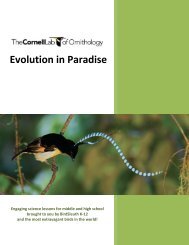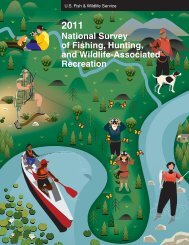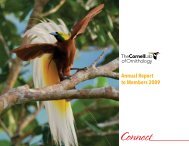More Highlights from <strong>2012</strong>••January: The journal Biology Lettersaccepts a <strong>Cornell</strong> <strong>Lab</strong> paper showing howclustered habitat networks are needed <strong>to</strong>maintain the genetic diversity <strong>of</strong> imperiledFlorida Scrub-Jays. The published paperprompts revision <strong>of</strong> the species’ EndangeredSpecies Act Recovery Plan.••february: Twenty-three youth from the nation’smajor cities come <strong>to</strong> the <strong>Lab</strong>’s “CelebrateUrban Birds” workshop, fostering connectionsbetween the arts, nature, and conservation. Saidone student, “The thing I loved most was ourwalk in the woods at night in silence—I havenever experienced anything like that before.”••march: <strong>Lab</strong> researchers return fromthe Central African Republic with rare images<strong>of</strong> endangered forest elephants at night,taken using thermal-sensing technology.••April: On Earth Day, the world watches anegg crack and a chick emerge in a Red-tailedHawk nest on the <strong>Cornell</strong> campus via a livestream from the <strong>Lab</strong>’s high-def cams.••may: Team Sapsucker ties the North Americanbirding record for most species found in 24hours. In the process they raise $250,000 fromsupporters’ pledges for bird conservation.••june: A new bird species found by <strong>Cornell</strong>graduates in Peru is named Capi<strong>to</strong> fitzpatrickiin honor <strong>of</strong> <strong>Lab</strong> direc<strong>to</strong>r John Fitzpatrick.••july: Citizen-science participants help betatestthe YardMap website and create more than2,400 bird-friendly backyard designs in the firstfour months.Sira Barbet (Capi<strong>to</strong>fitzpatricki) byMichael Harvey••august: The journal Conservation Biologypublishes results from the <strong>Lab</strong>’s deep-sea audiorecorders showing that noise from ships interfereswith the ability <strong>of</strong> endangered right whales<strong>to</strong> communicate with one another.••september: The <strong>Lab</strong> launches www.Birdcast.info, showcasing information about thenew project <strong>to</strong> forecast the migrations <strong>of</strong> birds.••oc<strong>to</strong>ber: The book Birds <strong>of</strong> Paradise:Revealing the World’s Most ExtraordinaryBirds is released, authored by <strong>Cornell</strong> <strong>Lab</strong> scientistEdwin Scholes and wildlife pho<strong>to</strong>grapherTim Laman.Marianna Hagbloom, New England Aquarium22From left <strong>to</strong> right: Millions <strong>of</strong> viewers around the world watched the Red-tailed Hawk hatchlings on the <strong>Cornell</strong> <strong>Lab</strong>’s bird cams. The rare image <strong>of</strong> a juvenile forest elephant at night was recorded by the <strong>Lab</strong>’sElephant Listening Project. The North Atlantic right whale is one <strong>of</strong> the critically endangered whale species moni<strong>to</strong>red by the <strong>Lab</strong>’s Bioacoustics Research Program.
A letter <strong>to</strong>Our donors<strong>2012</strong> was a miles<strong>to</strong>ne year for the <strong>Cornell</strong> <strong>Lab</strong>Paradise Riflebirdby Tim LamanMake Birds Your LegacyIt’s easy <strong>to</strong> include the <strong>Cornell</strong> <strong>Lab</strong> inyour estate plans—and sustain the studyand conservation <strong>of</strong> birds for generations <strong>to</strong>come. To make a bequest through your will,simply include the language: “I give and bequeaththe sum <strong>of</strong> $________ (or ___% <strong>of</strong>my residuary estate) <strong>to</strong> <strong>Cornell</strong> University, aneducational institution in Ithaca, NY, for the<strong>Lab</strong> <strong>of</strong> <strong>Ornithology</strong> <strong>to</strong> be used in support <strong>of</strong>its charitable purposes.” To learn more aboutestate planning opportunities that benefityou and the <strong>Lab</strong>, please call Scott Sutcliffeat (607) 254-2424. The <strong>Lab</strong> is pleased <strong>to</strong>acknowledge such friends in perpetuity asmembers <strong>of</strong> the Sapsucker Woods Society.••100,000 friends on the <strong>Lab</strong>’s Facebookpage, following our daily updates on birdsfrom exotic rainforests <strong>to</strong> familiar backyardbird feeders;••2,000,000 people around the world tunedin <strong>to</strong> the <strong>Lab</strong>’s web cams broadcasting the dailylives <strong>of</strong> nesting Great Blue Heron and RedtailedHawk families, from eggs <strong>to</strong> hatching <strong>to</strong>fledging;••100,000,000 eBird observations, themost year-round bird sightings ever recorded ina single database, thanks <strong>to</strong> the nearly 100,000eBirders who have submitted data on 9,500 <strong>of</strong>the planet’s 10,157 species <strong>of</strong> birds.Never before has the <strong>Cornell</strong> <strong>Lab</strong> reached somany people with our messages <strong>of</strong> discovery,wonderment, hope, and environmental stewardship.And this fall we’ll reach a whole new audiencewith the Birds-<strong>of</strong>-Paradise Project—a jointeffort with the National Geographic Society thatwill introduce magazine readers, primetime TVviewers, museum goers, and many more <strong>to</strong> thiselegantly plumed family <strong>of</strong> avifauna.The triumph <strong>of</strong> the Birds-<strong>of</strong>-Paradise Project isyour triumph, <strong>to</strong>o. You and other members wholeft estate gifts for the <strong>Lab</strong> made it possible for<strong>Lab</strong> scientist Edwin Scholes <strong>to</strong> launch researchexpeditions deep in<strong>to</strong> the interior <strong>of</strong> New Guinea’sjungles. And you should be as proud as we are <strong>to</strong>introduce the world <strong>to</strong> these incredible, strange,dazzling birds.There’s never been a better reason, nor a bettertime, <strong>to</strong> get the word out about our uniqueapproach <strong>to</strong> bird conservation through groundbreakingresearch, technological innovation,training and education, citizen science, and masscommunication via every possible channel. Soinvite your friends and family <strong>to</strong> discover thebirds-<strong>of</strong>-paradise and the <strong>Cornell</strong> <strong>Lab</strong> that youknow so well, and that you make possible withyour generosity and commitment <strong>to</strong> a betterworld for birds and all living things.Thank you so much for your support in <strong>2012</strong>,and I look forward <strong>to</strong> the many miles<strong>to</strong>nes we’llachieve <strong>to</strong>gether in 2013.Sincerely,Sean ScanlonSenior Direc<strong>to</strong>r, Development and Philanthropy(607) 254-1105; sbs259@cornell.edu23






